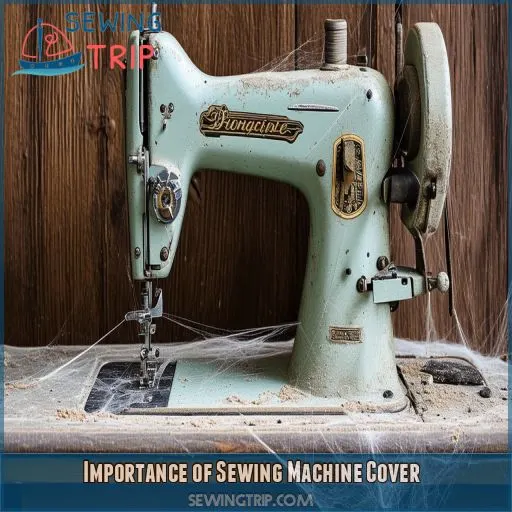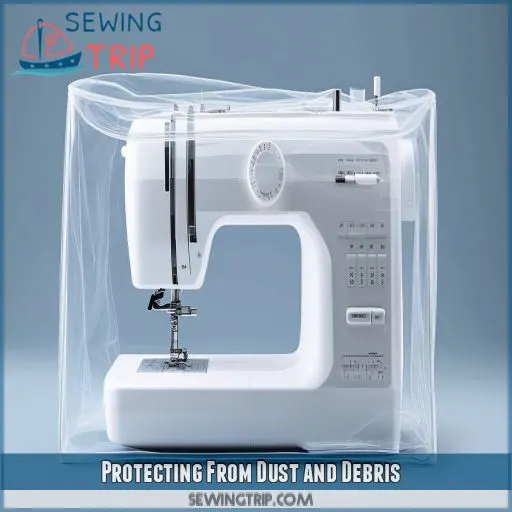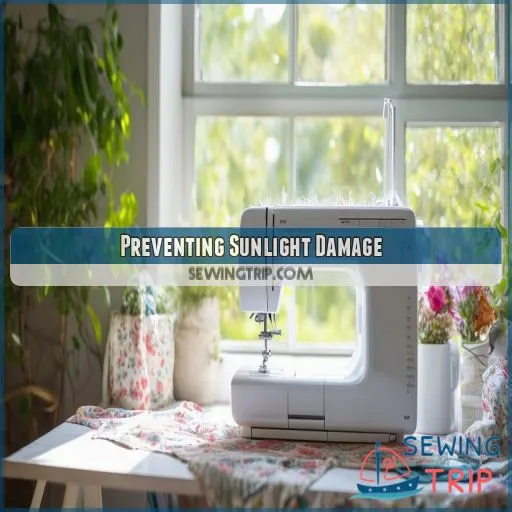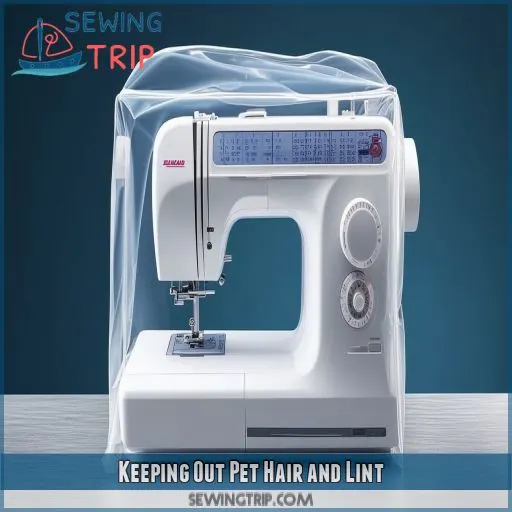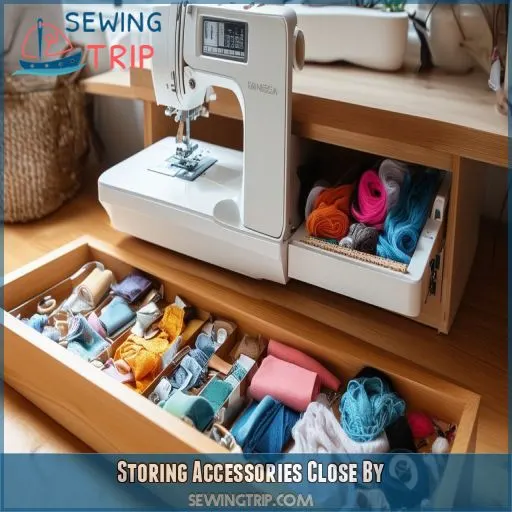This site is supported by our readers. We may earn a commission, at no cost to you, if you purchase through links.
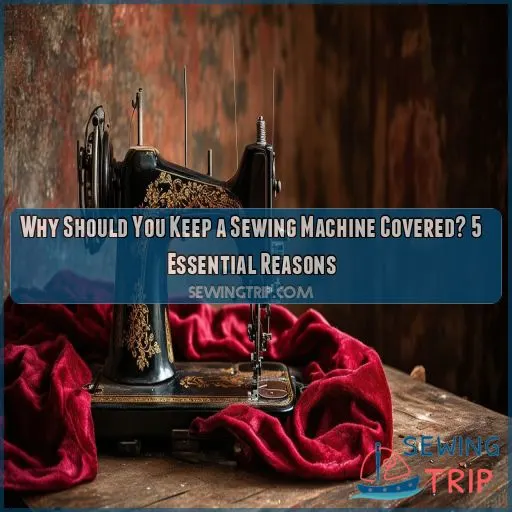
Knowing why you need to keep a sewing machine covered will save you headaches, time, and money—both as a professional seamstress and as someone new to sewing.
This article will talk about five vital reasons to protect your trusty stitching companion. Let us discuss the important role this uncomplicated, very effective practice plays.
Table Of Contents
Key Takeaways
- Keep that stitching sidekick under wraps! A cover shields your sewing machine from dust bunnies, sun-faded blues, and Fluffy’s fur – it’s like SPF 50 for your favorite gadget.
- Think of a sewing machine cover as your craft room’s superhero cape. It fights off wear and tear, keeps accessories close at hand, and might even add a pop of personality to your creative space.
- Uncovered machines are like open invitations for lint parties. Trust me, you don’t want to RSVP to that messy shindig – a cover keeps the riff-raff out and your machine purring like a kitten.
- Remember, a stitch in time saves nine, but a cover all the time saves your machine! It’s a small habit that’ll keep your trusty companion in tip-top shape for years of hemming and hawing.
Why Should You Keep a Sewing Machine Covered?
You should keep your sewing machine covered to protect it from environmental hazards and extend its life. A cover acts as a shield against dust, debris, pet hair, and lint that can clog the bobbin case and moving parts. It also guards against moisture buildup, corrosion, and UV damage from sunlight.
Your machine’s cosmetic appearance is preserved, preventing scratches and wear. Covers often come with pockets for organizing tools, keeping everything tidy and ready for your next creative burst.
Importance of Sewing Machine Cover
The sewing machine means much more than a tool to you; it’s your creative companion. That might be another reason the sewing machine cover is necessary—not only for preserving the machine itself but also for cleaning unwanted scraps of fabric. It’s about its life and performance; mainly, it’s about extending them.
A cover protects the sewing machine like armor when you aren’t working with it against accidents and other possible damages. But protection isn’t the only need a sewing machine cover would have.
It’s a creative expression avenue, allowing your personality to glow with another real touch in your sewing space. Pick one that suits best with your room decor or go for that fun sewing-themed print.
Plus, covers with pockets will help you in some basic space organization by keeping your essential tools within easy reach.
Keeping your machine in top condition means it’ll be there for you when inspiration strikes.
Protecting From Dust and Debris
Now that we can set a base for just how important a sewing machine cover really is, let’s get into its primary function: protecting your trusty machine from dust and debris. You’d be surprised how fast these tiny invaders can wreak havoc on your beloved sewing companion. Dust bunnies, air pollution, and pet dander are always on the lookout for ways to penetrate the inner sanctum of your precious machine.
More than a protective barrier, a well-fitted dust cover acts as protection against these pesky intruders:
- Lint and fabric particles clog the bobbin case
- Dust accumulation in the moving parts, which rub against each other
- Moisture buildup that can lead to rust and corrosion
Preventing Sunlight Damage
You don’t know, but even direct sunlight can have bad effects on your sewing machine. UV rays especially are known to cause fading in the colors of fabrics and plastic parts of machines. Keeping the machine covered provides essential protection from UV damage and prevents sunlight damage.
Think about your sewing machine as a delicate flower – it shouldn’t be left in the scorching sun. If you don’t cover it, colors can be faded from the outside of your machine, and it will register a very worn-out, tired look. The worse issue is plastics weaken after being scorched for some time under the sun, and may also deteriorate important parts.
If your machine has leather parts, they’ll only crack if left in direct sunlight. A cover does for your trusty stitching companion what sunscreen does for you: it protects from the bad rays.
Keep your sewing machine covered to protect it from sun damage so that it will be in great condition for the future.
Keeping Out Pet Hair and Lint
Besides the damage caused by sunlight, which is another threat your machine endures, there are pet hair and lint—factors of destruction. Any pet owner knows what it means to keep fur away from everything. Your sewing machine won’t be an exception either. Having a cover protects your machine from unwanted fur or cat and dog hair, even from pet dander.
It’s not just about pets, though. Lint from your projects can also make a mess of your machine. Here’s why a cover is crucial:
- It will catch the lint and prevent it from getting into such hard-to-reach places.
- It prevents tangling of your pet’s hair around the mechanisms of your machine.
- It helps to reduce the constant cleaning of your sewing tools.
Consider your sewing machine cover to be like the lint trap for a workspace. It’s much easier to shake out a cover than to vacuum your machine’s nooks and crannies. Moreover, a clean sewing machine assures that you’ll have chosen better fabric for operating and smoother sessions while sewing. Don’t let hair from pets and lint take over your crafting space!
Avoiding Wear and Tear
While keeping pet hair and lint at bay is critical, don’t forget that your sewing machine needs protection from wear and tear. The elements will indeed start having their subtle effect on your trusty stitching buddy over time. The dust just settles, and the debris might fall on delicate parts of the sewing machine, potentially leading to malfunctioning of parts or even rust. Even the sunbeams streaming through your craft room window may cause discoloration of fabric pieces on the exterior of the sewing machine.
With a cover, you provide protection from cosmetic damage. Those rounded edges and gleaming surfaces will be scratch-free, thus actualizing and maintaining the beauty of your machine. No less important is needle protection: an uncovered machine may cause the needles to bump in an unforeseen manner, then become dulled or broken.
It will also act as a barrier should you need to push things around on your sewing space. No more concern of accidentally pressing against the machine or catching loose threads in protruding parts. Your seam allowances and batting won’t catch on exposed elements with proper coverage, keeping your projects pristine.
Storing Accessories Close By
You’ve taken steps to protect your machine from wear and tear, but there’s another perk to keeping it covered: convenient accessory storage. A well-designed cover isn’t just about fabric protection; it’s a hub for organization. With strategically placed pockets, you’ll have thread organization at your fingertips. No more hunting for that elusive seam ripper or measuring tape!
Imagine reaching for your quilting cotton without rummaging through drawers. Your cover can house everything from bobbins to fusible fleece. It’s not just about tidiness; it’s about efficiency. You’ll trim loose threads and manage extension cords with ease.
Frequently Asked Questions (FAQs)
Why is it important to cover a sewing machine?
You’ll want to cover your sewing machine to protect it from dust, debris, and accidental damage. It’ll keep your trusty stitching companion in top shape, extending its life and ensuring it’s ready when inspiration strikes. Don’t let dust dull your creativity!
What is the purpose of a machine cover?
You’ll protect your machine from dust, debris, and accidental damage with a cover. It keeps your workspace tidy and extends your machine’s lifespan. Plus, you’ll have a handy spot to store small tools and accessories.
What is the best way to store a sewing machine?
You’ll treat your trusty machine like Fort Knox! Store it in a cool, dry place, cover it, and keep the dust out. Use a hard case if you must travel with it. Keep your machine clean and oiled, for regular maintenance will have this stitching for you whenever you need it.
Do you need a cover stitch machine?
You don’t necessarily need a cover stitch machine, but it’s handy for professional-looking hems on knits. If you frequently sew stretchy fabrics, it’s worth considering. Otherwise, your regular sewing machine can handle most tasks with the right techniques.
How often should I clean my sewing machine cover?
You’ve just dusted your sewing room, and your machine cover catches your eye. Clean it monthly, or when visibly dirty. Wipe with a damp cloth, using mild detergent for stubborn spots. You’ll keep your workspace fresh and inviting.
Can I use a plastic bag instead of a cover?
While you can use a plastic bag, it’s not ideal. It traps moisture, potentially causing rust. A proper cover protects against dust, sunlight, and accidental spills. It’ll also keep your machine looking tidy and professional in your sewing space.
What materials are best for homemade sewing machine covers?
Like a cozy blanket protects you from chilly nights, the best homemade sewing machine covers use fabrics that shield your machine from dust and damage. Cotton, canvas, or quilted materials are ideal choices. They’re durable, breathable, and easy to clean.
Should I remove the cover before using the machine?
Yes, remove the cover while using your sewing machine. It protects the machine when not in use; however, sometimes parts get in the way of how one operates. Removing it will ensure there’s enough ventilation and access to all parts during sessions.
Are there covers available for specific sewing machine models?
Just as a tailor crafts a suit to fit, manufacturers design covers for specific models. You’ll find custom-fit options that snugly protect your machine. They’re like a second skin, ensuring your sewing companion stays dust-free and ready for action.
Conclusion
Like a shield for your trusty companion, keeping your sewing machine covered is a simple yet powerful practice.
You’ve learned why you should keep a sewing machine covered: it protects from dust, sunlight damage, pet hair, and wear and tear.
By adopting this habit, you’ll extend your machine’s life, maintain its performance, and keep accessories close at hand.
Don’t let neglect threaten your sewing projects. Make covering your machine a routine, and you’ll reap the benefits of a well-maintained, long-lasting sewing partner.

